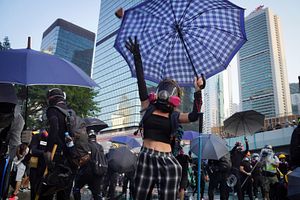In recent months, Hong Kong’s “summer of discontent” has captivated the world. One question that has sat in the back of many minds and the front of newspapers is whether or not Hong Kong will become another Tiananmen Square, subject to the same brutal and bloody treatment as students and workers suffered in Beijing on June 4, 1989.
Knowing the future requires understanding the past. What exactly, then, is similar or different between the two movements? Yang Jianli (杨建利), a Chinese dissident and participant in the 1989 Tiananmen Student Movement, shared his insights on the question at the Human Rights Foundation’s Oslo Freedom Forum in Taipei last week. Yang compared 1989 with what some have called Hong Kong’s “Water Revolution” by noting three main differences: experience of freedom, realism, and technology.
According to Yang Jianli, “[the Tiananmen Square protesters] never had the experience of freedom.” The protesters who sought to end corruption and (in many cases) ultimately to enact what Wei Jingsheng called the Fifth Modernization — political reform — came into the square with a background of absolute terror. The trauma of the Cultural Revolution was the backdrop of the democracy movement. Hong Kongers are not the same.
Yang is right. While refugees from the Cultural Revolution were the fuel of Hong Kong’s development and make up a significant component of the Hong Kong population, the trauma of the Cultural Revolution is not nearly as close to the minds of the young people in the streets of Hong Kong as it was for the generation of 1989. The young people at the forefront of the Water Revolution are instead the first born after the Handover in 1997, raised in a Hong Kong that always has been under Chinese rule, but where civil society remained vibrant and freedom of speech preserved.
The second difference noted by Yang Jianli is Hong Kongers’ sobriety about the capabilities of the Chinese military and surveillance state. “[The Tiananmen students] never thought the Chinese military would massacre them,” so no measures were taken to prevent the worst case scenario. In Hong Kong, in contrast, people are under absolutely no illusions. They are fully aware of the potential ruthlessness and bloodshed of the Chinese state and act accordingly. “[The protesters] have hidden behind masks, surveillance cameras have been painted over, and some have even given up their smartphones and subway cards — preferring single-use tickets for trains instead, hoping to avoid tracking,” reported the South China Morning Post in August.
Beyond protecting their own identities in a way that makes punishing any individuals a challenge, the Hong Kong protesters have adopted techniques summarized in the slogan “Be Water.” They shy away from large-scale occupations: “a rally may turn into a march; a march may begin in one direction and abruptly change to another direction.” Both the anonymity and rapid change potential of protest decisions stand in stark contrast to the student movement in 1989, when student groups marched to the square wearing no masks, occupying one of the largest open spaces in Beijing. “Be Water” techniques make identifying and prosecuting individuals difficult for the government, but the techniques also ensure that protests can form and dissolve, ebb and flow, never congealing enough to be massacred by the People’s Liberation Army.
Yang’s third point was that the Hong Kong protests are leaderless (or “leaderful,” to borrow a term from fellow Oslo Freedom Forum panelist Johnson Yeung). The movement is mass-scale and coordinated, yet has lasted for a long duration. Needs are communicated across large crowd distances through an innovative sign language. Decisions are made instantaneously through apps like Telegram and AirDrop, subject to democratic input. The revolution is not only televised; it is texted, signed, and open-source. This stands in stark contrast to the days of 1989. The movement in Beijing was led by a core group, representing the universities from whence they came from. That is not their fault as much as it is a product of an era where instant communication and democratic decision-making was technologically unfeasible. Leaders like Wang Dan, Shen Tong, and Chai Ling could only make decisions so quickly across massive distances.
There are, however, many similarities between the movements. One that Yang Jianli pointed out is that young people play a primary role in the engines of both movements. Another, I would add, is that both 1989 and 2019 present a fundamental vision for the future that competes with that of the central government. However, experience of freedom, realism, and technology are major differences between the two moments in history. These differences bode well for the prospects of today’s Water Revolution. Even if it does not succeed, at least individual protesters can rest knowing they will likely be much safer in a post-protest Hong Kong than their counterparts in 1989 were.
Travis Sanderson is a Huayu Scholar and independent writer based in Taipei.

































